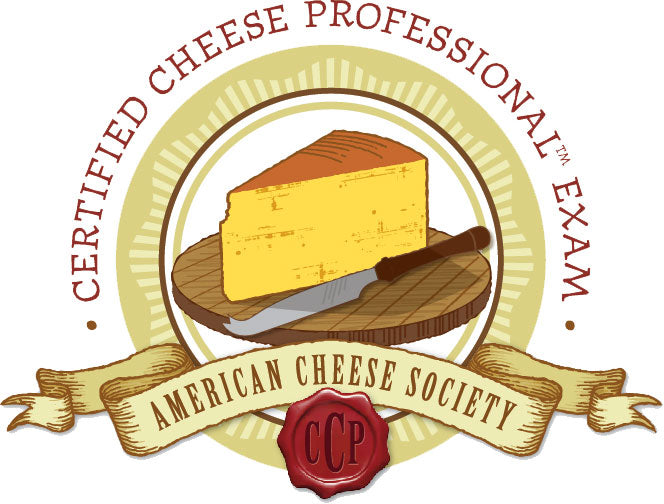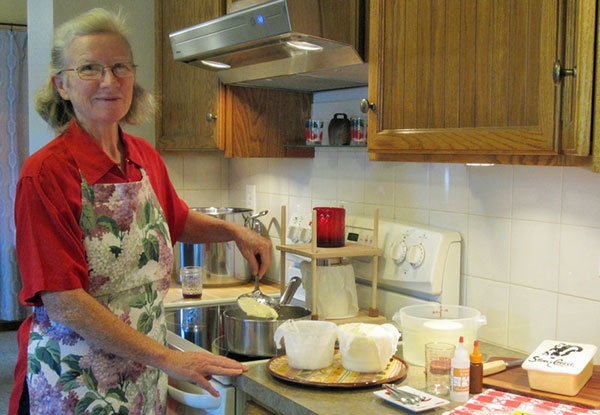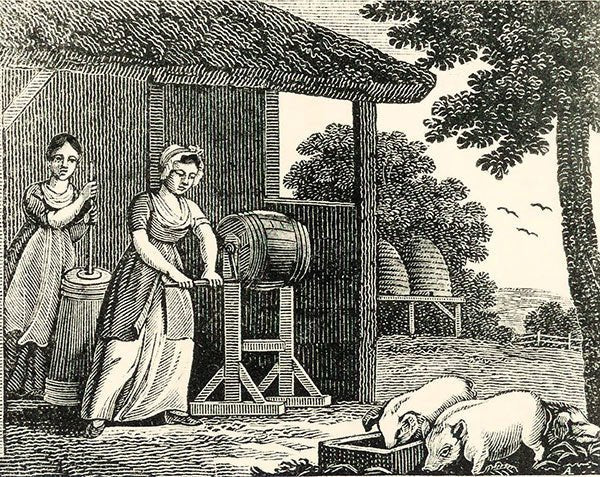
It has been 7 years since the American Cheese Society began it’s certification program for cheese professionals and there are currently only 900 people who have passed the exam in the United States, Canada, Australia, Mexico, and Europe. Becca Heins is now a member of this elite group.

Becca began taking classes from our longtime friend, Kate Johnson at The Art of Cheese in Longmont, Colorado 5 years ago. She soon became Kate’s assistant and now she is a co-teacher at the school. She also schedules classes at her home.

Making cheese at home
When she sent us the picture below, we were astounded by the beauty of her cheeses! She told us, “These are just for fun. The 3 dimensional designs are cheese, not wax. I made some “stencils” that I insert in the form before I press the cheeses. Clear waxed cheeses – I collected flowers and leaves from my yard and embed them when I wax the cheese. The calico (purple one) is a bandaged cheese. The first layer is butter muslin, then the calico for the 2nd layer.”

Interview
Where did you grow up?
I grew up in a 4H family – my mom worked as a County Extension Agent. She taught me to cook, sew, can and preserve food. We lived in dairy country in SE Minnesota, but until that class, it hadn’t occurred to me that I could make my own cheese at home.
What made you decide to make cheese?
I really got started just by chance. I took a Saturday afternoon mozzarella class in 2012. (I didn’t know about The Art of Cheese or Kate at the time). It was a big class, maybe 20 – 25, but only one person successfully made a beautiful stretched mozzarella. My curiosity did the rest! I came home from that class and looked online to see if I could learn more. I found your fabulous NECS site (cheesemaking.com), with supplies and tons of info. I started reading, placed an order, and started making cheese!
A friend of a friend introduced me to Kate and The Art of Cheese. I took some AoC classes and started volunteering to help out. As Kate’s business grew, she welcomed an assistant.

(Second from right) 2015 -The very first 3 day cheese making workshop we hosted at The Art of Cheese. I think that was the first event at which I worked for Kate.
After awhile we started co-teaching, and then I started teaching classes at AoC on my own.

Teaching at AoC

It’s been really fun to meet other home cheese makers. Some have dairy animals (I don’t) and I have volunteered at their farms. I’ve been lucky to learn first hand more about small scale dairy farming, and making cheese with farm fresh milk. Before I knew it, I had won first place in a local home cheese making contest!
The contest was sponsored AoC in the summer of 2015 (this was before I started working for Kate). We had some judges from Haystack Mountain Creamery. It was a blind tasting – a couple slices to the judges (ID’d by a number), the rest put out for the crowd to sample.

Sampling the entries and more.
What cheeses have you made so far?
I’ve tried making most of the cheese styles at home:
Fresh – Chèvre style, cottage cheese, ricotta, quark, queso fresco and feta
Soft ripened/bloomies – Crottin de Chavignol, Valencay, Camembert. I’ve made these with and without ash.
Washed curd – Colby & Jack
Washed rind – Taleggio style
Alpines – I’ve tried several recipes – baby swiss, jarlsberg, gruyere. But, I don’t think any I’ve made so far would win a blue ribbon.
Blues – Cambozola, Fourme d’Ambert, Stilton, blue logs. These have been a little tricky to get the moisture in the curd just right, but I’m optimistic about my most recent one. We’ll know in about 3 months.
Pasta filata – 30 minute mozzarella mostly. I tried a cultured mozzarella which turned out fine but my timing was off so I didn’t finish it til almost midnight, haha. Need to work on my timing on that one.
Cheddar – I’ve made some good ones, but this is not a style I make very often since there are many excellent cheddars available commercially.
Hard – I like to experiment with different affinage techniques using the Guido recipe in Ricki’s book. Natural rind, wrapped in macerated grape leaves, waxed. Also, I’ve been very pleased with cheeses made following Jim’s Dry Jack recipe.
I really like to make the bloomies with fresh goat milk when I can get it. They are fun to make because of the visual changes.

An assortment of Becca’s bloomies, aged hard, and blue cheeses
My husband likes my version of Taleggio, so I try to make those fairly regularly. One of my personal favorites is the Dry Jack. I make a 4 gallon wheel and age it a year, so I try to make one every 4 – 6 months.
What kind of milk are you using?
I’ve been lucky enough to work with fresh goat, sheep, and cow milks. But I also make cheese from regular grocery store milk and cream line milks from local dairies.

A couple of cheese trays

A holiday cheese wreath. I made the crisps and the other cheeses (mozz, feta, and parm if I recall correctly), and grew the rosemary and bay.
Tell us about the certification …
The CCP exam is designed for anyone working in the cheese industry – from herd masters to cheese makers to cheese mongers, writers, importers and more. It covers best practices for cheese making as well as some history and science, and the food safety regulations that apply to the cheese industry. I figured studying for the exam would keep me motivated to learn about some of these broader topics.
I prepped for the exam over a period of about 6 months. I read a lot, took some online courses, and visited and/or did internships at local artisan creameries and small local dairy farms. I visited several better quality cheese shops, and made (and ate!) cheese. The ACS has something they call the Body of Knowledge, which encompasses 9 different areas of study. They also have a Best Practices Guide for Cheese Makers. Both are great sources of information on all things cheese.
Finally, we see a number of aspiring artisan cheese makers at The Art of Cheese workshops. They often have more technical questions than a typical home cheese maker. Learning enough to earn my certification was a way for me – in my role of cheese making instructor – to address more their questions.
Some of the attendees are professional chefs, as well as people from out of state. AoC now offers these 3 day workshops 3-4 times each year. We teach 9-10 cheese makes, tour a local farm and have other “cheesy” activities. They almost always sell out. We have had cheese enthusiasts and beginning professionals come from as far away as Iceland, Canada, and Brazil!
What are your goals?
I’m really happy to be a home cheese maker and cheese making instructor. I enjoy sharing the knowledge I’ve gained with others, and learning from the greater cheese community.
And of course, I want to continue to improve my own cheese making!
Here’s a short video Becca made:














































































































































